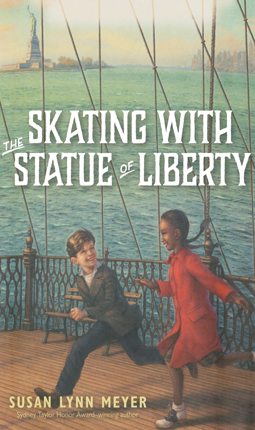| Skating with the Statue of Liberty Author: Meyer, Susan | ||
| Price: $6.50 | ||
Summary:
After having escaped with his family from Nazi-occupied France, Gustave finds a home in New York City, still worried about Marcel, his good friend who he left behind, and surprised to find bigotry in America, too.
| Accelerated Reader Information: Interest Level: MG Reading Level: 4.80 Points: 10.0 Quiz: 181415 | Reading Counts Information: Interest Level: 6-8 Reading Level: 4.40 Points: 15.0 Quiz: 68610 | |
Reviews:
Kirkus Reviews (02/01/16)
School Library Journal (02/01/16)
Booklist (05/01/16)
The Hornbook (00/05/16)
Full Text Reviews:
School Library Journal - 02/01/2016 Gr 4–7—In this follow-up to Black Radishes (Delacorte, 2010), Meyer continues the story of a French Jew named Gustave, now 12, who emigrates with his parents to safety in the United States during World War II. Based on memories from the author's father, the story rings true as Gustave starts school at the Joan of Arc Junior High in New York City. His challenges learning English and navigating American culture make for a difficult start for the protagonist, along with his worries about his best friend, Marcel, whom he left behind in France to an uncertain fate. His friendship with September Rose, an African American girl at his school, makes his life easier in some ways, but he also encounters threats for being friends with someone of a different race. Eventually, he joins a French Boy Scout troop, which bring him pleasure, and he begins to fit in at school as his English improves. Letters from a friend in France, though censored by the Nazis, bring news from home and help Gustave appreciate the freedoms he now enjoys. Meyer brings in some very realistic details to the story, such as Gustave's mother's struggle at the grocery store, where bargaining is not customary as it was in France; the family's first experience with a banana; and Gustave's negative reaction to police officers. Gustave is disappointed to encounter racism and religious intolerance in America, where he finds "liberty and justice for all" is not always the case. September Rose has a teenage brother heavily involved in the Double V Campaign against racial segregation. The interaction between black teens and the New York City police is disturbingly similar to current newspaper headlines. Despite the heavy topics covered, the everyday details of the story guide readers, allowing them to enjoy following Gustave's entry into the United States and his growth toward appreciating all that's ahead for him in his new home. Meyer doesn't try to pretty up Gustave's experience, lending this work a strong note of authenticity. VERDICT Although not a book likely to fly off the shelves, it should still be considered a first purchase for its strong historical content, rich descriptions, and smart subtleties about the links between history and current events.—Kathy Kirchoefer, Henderson County Public Library, NC - Copyright 2016 Publishers Weekly, Library Journal and/or School Library Journal used with permission.
Booklist - 05/01/2016 January 1942: Gustave and his family arrive in New York after fleeing Nazi-controlled France in Black Radishes (2010). But his thoughts remain with his best friend, Marcel, location unknown. Gradually Gustave creates a new life: learning English, joining a French Boy Scouts troop, earning money so he can buy long pants and look like an American boy. Coded letters from his friend Nicole in St. Georges keep him apprised of the situation in France and the search for news about Marcel. Through his friendship with an African American girl, Gustave learns about race relations and the Double V Campaign for racial equality, with sharp parallels drawn between the treatment of Jews in France and blacks in America. Well paced with fully realized characters, this provides a textured look at race, refugees, war, and the process of creating a new life. The story is loosely based on the author’s family history and includes an extensive author note.The book’s unique focus on a perennial topic earns it a place on library shelves. - Copyright 2016 Booklist.



